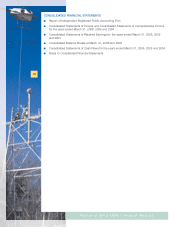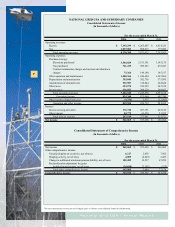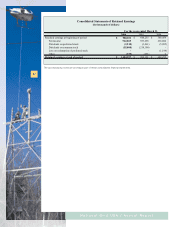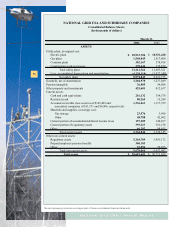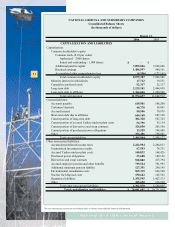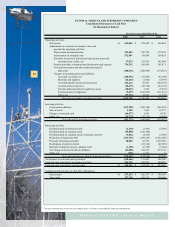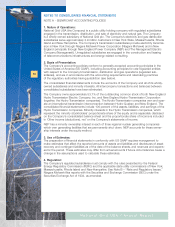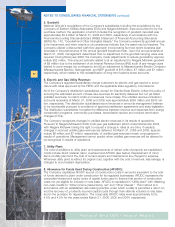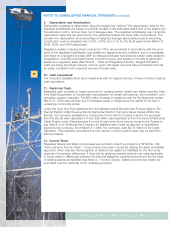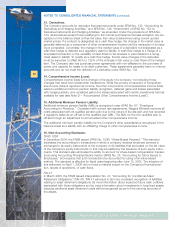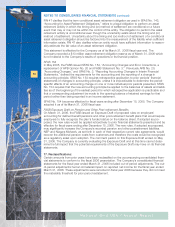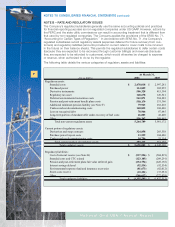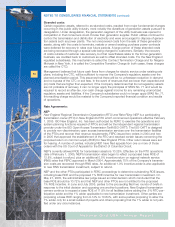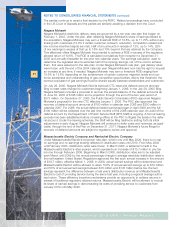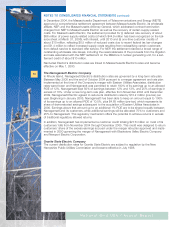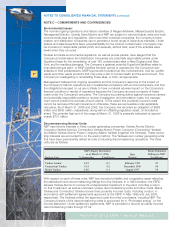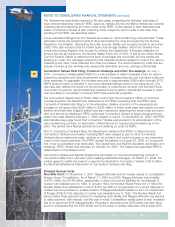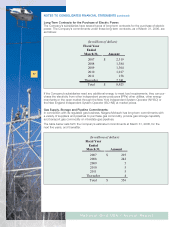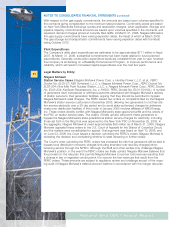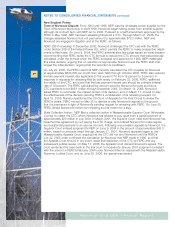National Grid 2006 Annual Report Download - page 39
Download and view the complete annual report
Please find page 39 of the 2006 National Grid annual report below. You can navigate through the pages in the report by either clicking on the pages listed below, or by using the keyword search tool below to find specific information within the annual report.
NOTES TO CONSOLIDATED FINANCIAL STATEMENTS (continued)
13. Derivatives:
The Company accounts for derivative financial instruments under SFAS No. 133, “Accounting for
Derivatives and Hedging Activities,” and SFAS No. 149, “Amendment of SFAS No. 133 on
Derivative Instruments and Hedging Activities,” as amended. Under the provisions of SFAS No.
133, all derivatives except those qualifying for the normal purchase/normal sale exception are rec-
ognized on the balance sheet at their fair value. Fair value is determined using current quoted
market prices. If a contract is designated as a cash flow hedge, the change in its market value is
generally deferred as a component of other comprehensive income until the transaction it is hedg-
ing is completed. Conversely, the change in the market value of a derivative not designated as a
cash flow hedge is deferred as a regulatory asset or liability. A cash flow hedge is a hedge of a
forecasted transaction or the variability of cash flows to be received or paid related to a recog-
nized asset or liability. To qualify as a cash flow hedge, the fair value changes in the derivative
must be expected to offset 80% to 125% of the changes in fair value or cash flows of the hedged
item. The Company also has purchase power agreements with non-affiliates for the purchase of
power and capacity for resale to its retail customers. These agreements generally have no notional
amounts and do not meet the definition of a derivative under SFAS No. 133.
14. Comprehensive Income (Loss):
Comprehensive income (loss) is the change in the equity of a company, not including those
changes that result from shareholder transactions. While the primary component of comprehen-
sive income (loss) is reported net income, the other components of comprehensive income (loss)
relate to additional minimum pension liability recognition, deferred gains and losses associated
with hedging activity, and unrealized gains and losses associated with certain investments held as
available for sale (see Note D – “Accumulated Other Comprehensive Income (Loss)”).
15. Additional Minimum Pension Liability:
Additional minimum pension liability (AML) is recognized under SFAS No. 87, “Employers’
Accounting for Pensions.” Consistent with current rate agreements, Niagara Mohawk recovers all
costs associated with its qualified pension plan due to the nature of its rate plan and has recorded
a regulatory asset as an off-set to the qualified plan AML. The AML for the non-qualified plan is
off-set through an adjustment to accumulated other comprehensive income.
The additional minimum pension liability for the Company’s other subsidiaries is recognized in the
balance sheet as a liability with an offsetting charge to other comprehensive income.
16. New Accounting Standards:
SFAS 123R
In December 2004, the FASB issued SFAS No. 123R, “Share-Based Payment.” This standard
addresses the accounting for transactions in which a company receives employee services in
exchange for (a) equity instruments of the company or (b) liabilities that are based on the fair value
of the company’s equity instruments or that may be settled by the issuance of such equity instru-
ments. This standard also eliminates the ability to account for share-based compensation transac-
tions using Accounting Principles Board Opinion (APB) No. 25, “Accounting for Stock Issued to
Employees,” and requires that such transactions be accounted for using a fair-value-based
method. The standard is effective for fiscal years beginning after June 15, 2005. The adoption of
this statement on April 1, 2006 did not have a material impact on the Company’s financial posi-
tion, results of operations, or cash flows.
FIN 47
In March 2005, the FASB issued Interpretation No. 47, “Accounting for Conditional Asset
Retirement Obligations,” (FIN 47). FIN 47 will result in (a) more consistent recognition of liabilities
relating to asset retirement obligations, (b) more information about expected future cash outflows
associated with those obligations and (c) more information about investments in long-lived assets
because additional asset retirement costs will be recognized as part of the carrying amounts of
the assets.
39
National Grid USA / Annual Report


